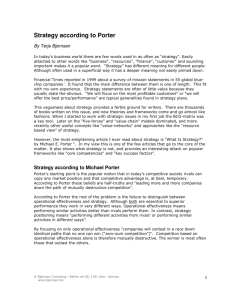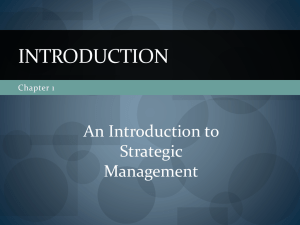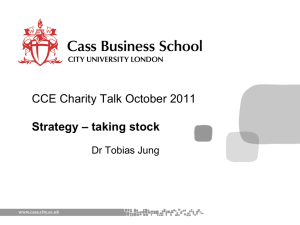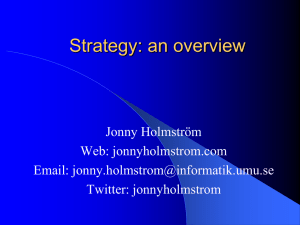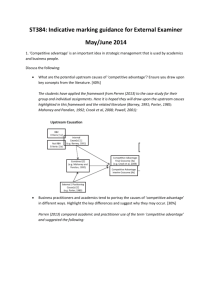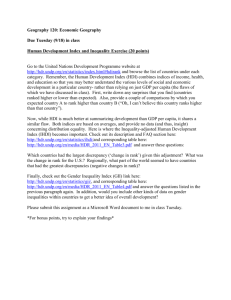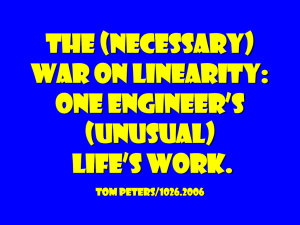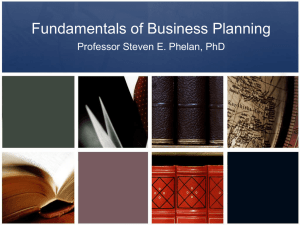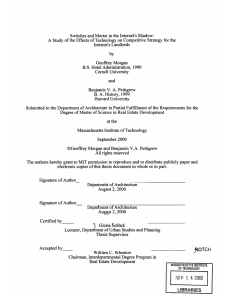STRATEGIC THINKING AND PLANNING
advertisement
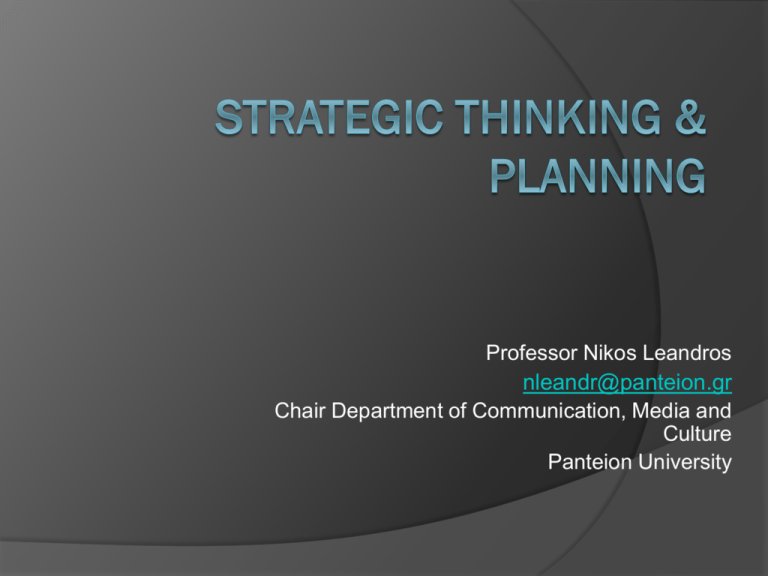
Professor Nikos Leandros nleandr@panteion.gr Chair Department of Communication, Media and Culture Panteion University "If you know the enemy and know yourself, you need not fear the results of a hundred battles. If you know yourself but not the enemy, for every victory gained you will also suffer a defeat. If you know neither the enemy nor yourself, you will succumb in every battle.“ - Sun Tsu "If you are planning for one year, grow rice. If you are planning for 20 years grow trees. If you are planning for centuries, grow men". - Chinese Proverb STRATEGIC PLANNING • An organization's process of defining its strategy, or direction, and making decisions on allocating its resources to pursue this strategy. In order to determine the direction of the organization, it is necessary to understand its current position and the possible avenues through which it can pursue a particular course of action OPERATIONS MANAGEMENT Tries to ensure that business operations are: • Efficient in terms of using as few resources as needed • Effective in terms of meeting customer requirements It involves working closely with departments and administration to improve the alignment of strategy, performance measures, and processes to improve visibility and predictability of operations ALTERNATIVE THEORIES & PERSPECTIVES • Henry Mintzberg examined the strategic process and concluded it was much more fluid and unpredictable than people had thought. Because of this, he could not point to one process that could be called strategic planning. Instead Mintzberg concludes that there are five types of strategies (the 5 P of Mintzberg): (1) Strategy as Plan – a direction, guide, course of action – intention rather than actual (2) Strategy as Ploy – a maneuver intended to outwit a competitor (3) Strategy as Pattern – a consistent pattern of past behaviour – realized rather than intended (4) Strategy as Position – locating of brands, products, or companies within the conceptual framework of consumers or other stakeholders (5) Strategy as Perspective – strategy determined primarily by a master strategist • There are two main approaches, which are opposite but complement each other in some ways, to strategic management: (1) The Industrial-Organizational model (IO) looks at the structure of the industries within which firms operate. Strategy as an adaptation to the external environment (2) The Resource Based View (RBV) approach examines the core resources that a firm has at its disposal. The RBV model focuses on the rareness, non-substitutability, value and uniqueness of the organization's core resources. • Hamel and Prahalad declared that strategy needs to be more active and interactive; less “arm-chair planning” was needed. They introduced terms like strategic intent and strategic architecture. Their most well known advance was the idea of core competency. • Michael Porter introduced many new concepts including; 5 forces analysis, generic strategies, and the value chain. In 5 forces analysis he identifies the forces that shape a firm's strategic environment. It is like a SWOT analysis with structure and purpose. It shows how a firm can use these forces to obtain a sustainable competitive advantage. Philip Selznick introduced the idea of matching the organization's internal factors with external environmental circumstances. This core idea was developed into what we now call SWOT analysis Porter's generic strategies (1) Cost minimization (2) Product differentiation (3) Market focus Company development strategies (1) Vertical integration (2) Horizontal integration (3) Diversification (related and unrelated) of products and markets (3) Internationalization Methods (1) Franchises - Alliances (2) Mergers and acquisitions (3) Joint ventures (4) Organic growth Advantages-Disadvantages (1) Economies of scale (2) Economies of scope (3) Personal power and wealth (4) Non-economic advantages (political influence) The New York Times Group’s response to the challenges posed by technological transformation and economic crisis OBJECTIVE: To help participants understand problems facing companies and propose solutions and new strategies. ESTIMATED TIME: 1 hour MATERIALS: Internet access, paper and pencil DESCRIPTION: Analyze the challenges facing a “traditional” media company (New York Times Group) and discuss strategic thinking and planning. http://www.nytco.com/investors/financials/annual_reports.html Hamel, G. and Prahalad, C. (1994) Competing for the Future. Boston: Harvard Business School Press. Mintzberg, H. (2000) The Rise and Fall of Strategic Planning. London: Prentice Hall. Porter, M. (1985) Competitive Advantage: Creating and Sustaining Superior Performance. New York: Free Press. Thompson, A. and Strickland, A. (2001) Strategic Management. Concepts and Cases. New York: McGraw – Hill. Climate Change and Sustainable Development OBJECTIVE: To help participants understand a global environmental problem and propose measures and activities for sustainable development ESTIMATED TIME: 1 hour MATERIALS: Internet access, paper and pencil DESCRIPTION: Case study two presents a global problem (climate change) that requires strategic thinking and action at international and local level. Corporate governance should promote environmental responsibility as an integral part of sustainable development. http://hdr.undp.org/en/reports/ Dresner, S. (2008) The Principles of Sustainability. London: Earthscan. UNDP, Human Development Report, 1990-2012. URL, http://hdr.undp.org/en/reports/ United Nations (1987) Report of the World Commission on Environment and Development: Our Common Future. Official Records of the General Assembly, A/42/427 Dias Media Group OBJECTIVE: To help participants understand problems facing companies and propose solutions and new strategies. ESTIMATED TIME: 1 hour MATERIALS: Internet access, paper and pencil DESCRIPTION: Analyze the challenges facing a media company and discuss strategic thinking and planning.
